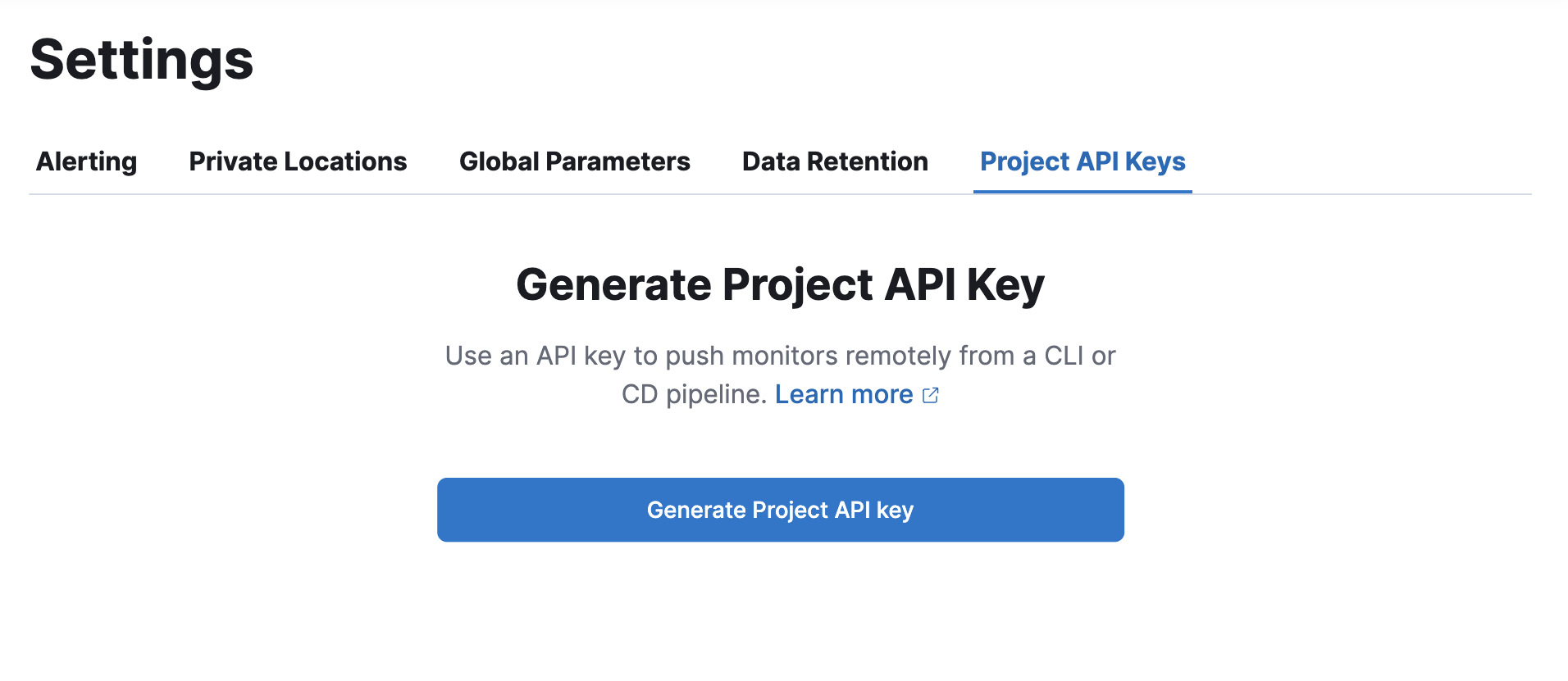- Elastic Cloud Serverless
- Elasticsearch
- Elastic Observability
- Get started
- Observability overview
- Elastic Observability Serverless billing dimensions
- Create an Observability project
- Quickstart: Monitor hosts with Elastic Agent
- Quickstart: Monitor your Kubernetes cluster with Elastic Agent
- Quickstart: Monitor hosts with OpenTelemetry
- Quickstart: Unified Kubernetes Observability with Elastic Distributions of OpenTelemetry (EDOT)
- Quickstart: Collect data with AWS Firehose
- Get started with dashboards
- Applications and services
- Application performance monitoring (APM)
- Get started with traces and APM
- Learn about data types
- Collect application data
- View and analyze data
- Act on data
- Use APM securely
- Reduce storage
- Managed intake service event API
- Troubleshooting
- Synthetic monitoring
- Get started
- Scripting browser monitors
- Configure lightweight monitors
- Manage monitors
- Work with params and secrets
- Analyze monitor data
- Monitor resources on private networks
- Use the CLI
- Configure a Synthetics project
- Multifactor Authentication for browser monitors
- Configure Synthetics settings
- Grant users access to secured resources
- Manage data retention
- Scale and architect a deployment
- Synthetics Encryption and Security
- Troubleshooting
- Application performance monitoring (APM)
- Infrastructure and hosts
- Logs
- Inventory
- Incident management
- Data set quality
- Observability AI Assistant
- Machine learning
- Reference
- Get started
- Elastic Security
- Elastic Security overview
- Security billing dimensions
- Create a Security project
- Elastic Security requirements
- Elastic Security UI
- AI for Security
- Ingest data
- Configure endpoint protection with Elastic Defend
- Manage Elastic Defend
- Endpoints
- Policies
- Trusted applications
- Event filters
- Host isolation exceptions
- Blocklist
- Optimize Elastic Defend
- Event capture and Elastic Defend
- Endpoint protection rules
- Identify antivirus software on your hosts
- Allowlist Elastic Endpoint in third-party antivirus apps
- Elastic Endpoint self-protection features
- Elastic Endpoint command reference
- Endpoint response actions
- Cloud Security
- Explore your data
- Dashboards
- Detection engine overview
- Rules
- Alerts
- Advanced Entity Analytics
- Investigation tools
- Asset management
- Manage settings
- Troubleshooting
- Manage your project
- Changelog
Configure Synthetics settings
editConfigure Synthetics settings
editThere are several Synthetics settings you can adjust in your Observability project.
Alerting
editAlerting enables you to detect complex conditions using rules across Elastic Observability Serverless and send a notification using connectors.
When you create a new synthetic monitor, new default synthetics rules will be applied. To edit the default rules:
- Click Alerts and rules in the top bar.
-
Select a rule to open a panel where you can edit the rule’s configuration:
- Monitor status rule for receiving notifications for errors and outages.
- TLS certificate rule for receiving notifications when one or more of your HTTP or TCP lightweight monitors has a TLS certificate expiring within a specified threshold or when it exceeds an age limit.
However, the automatically created Synthetics internal alert is intentionally preconfigured, and some configuration options can’t be changed. For example, you can’t change how often it checks the rule.
If you need specific alerting behavior, set up a different rule. To view all existing rules or create a new rule:
- Click Alerts and rules in the top bar.
- Click Manage rules to go to the Rules page.
On the Rules page, you can manage the default synthetics rules including snoozing rules, disabling rules, deleting rules, and more.
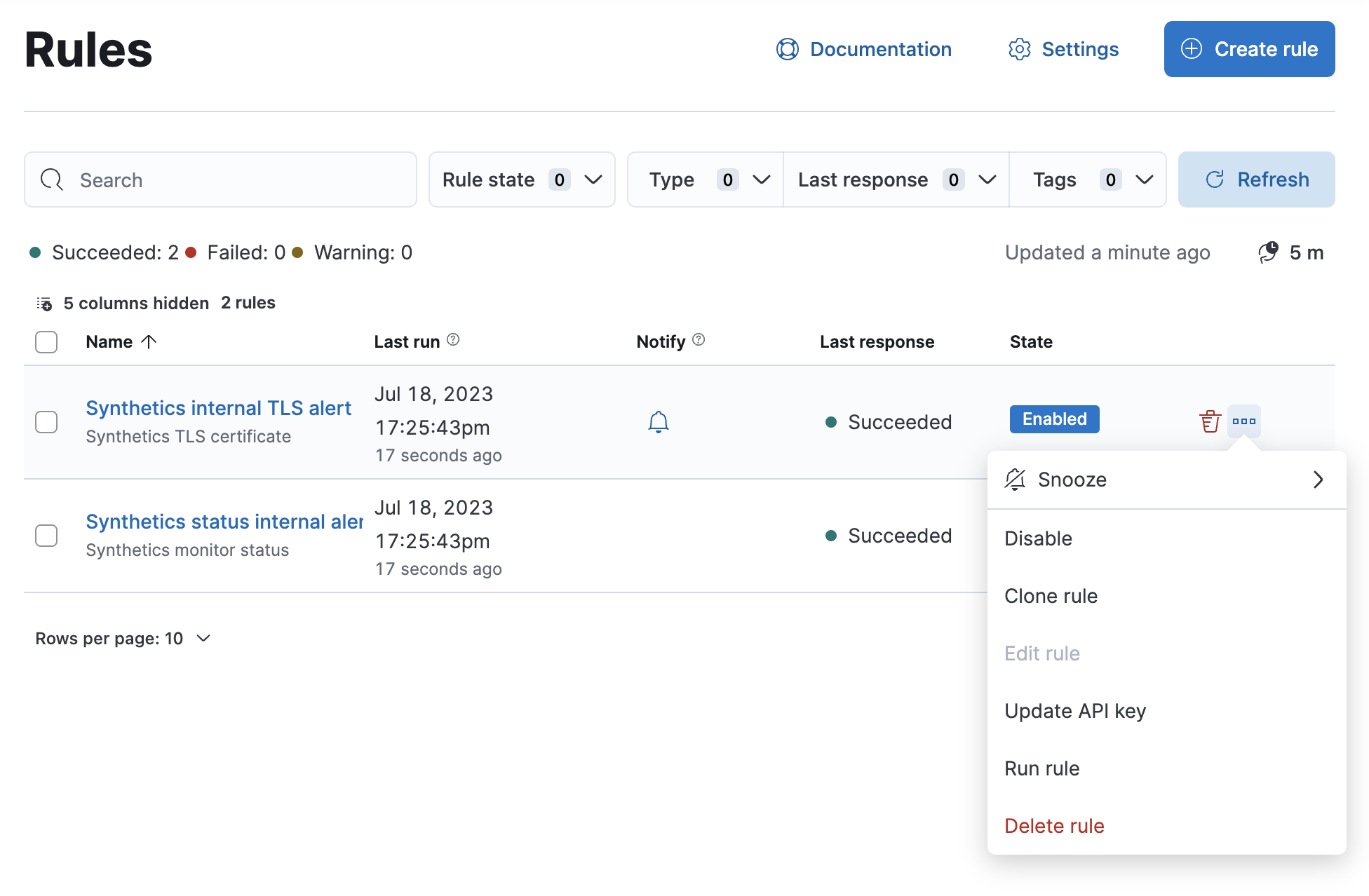
You can enable and disable default alerts for individual monitors in a few ways:
- In the UI when you create a monitor.
- In the UI after a monitor is already created, on the Monitors page or on the Edit monitor page for the monitor.
- In a Synthetics project when configuring a lightweight monitor.
In the Alerting tab on the Synthetics Settings page, you can add and configure connectors. If you are running in Elastic Cloud, then an SMTP connector will automatically be configured, allowing you to easily set up email alerts. Read more about all available connectors in Action types.
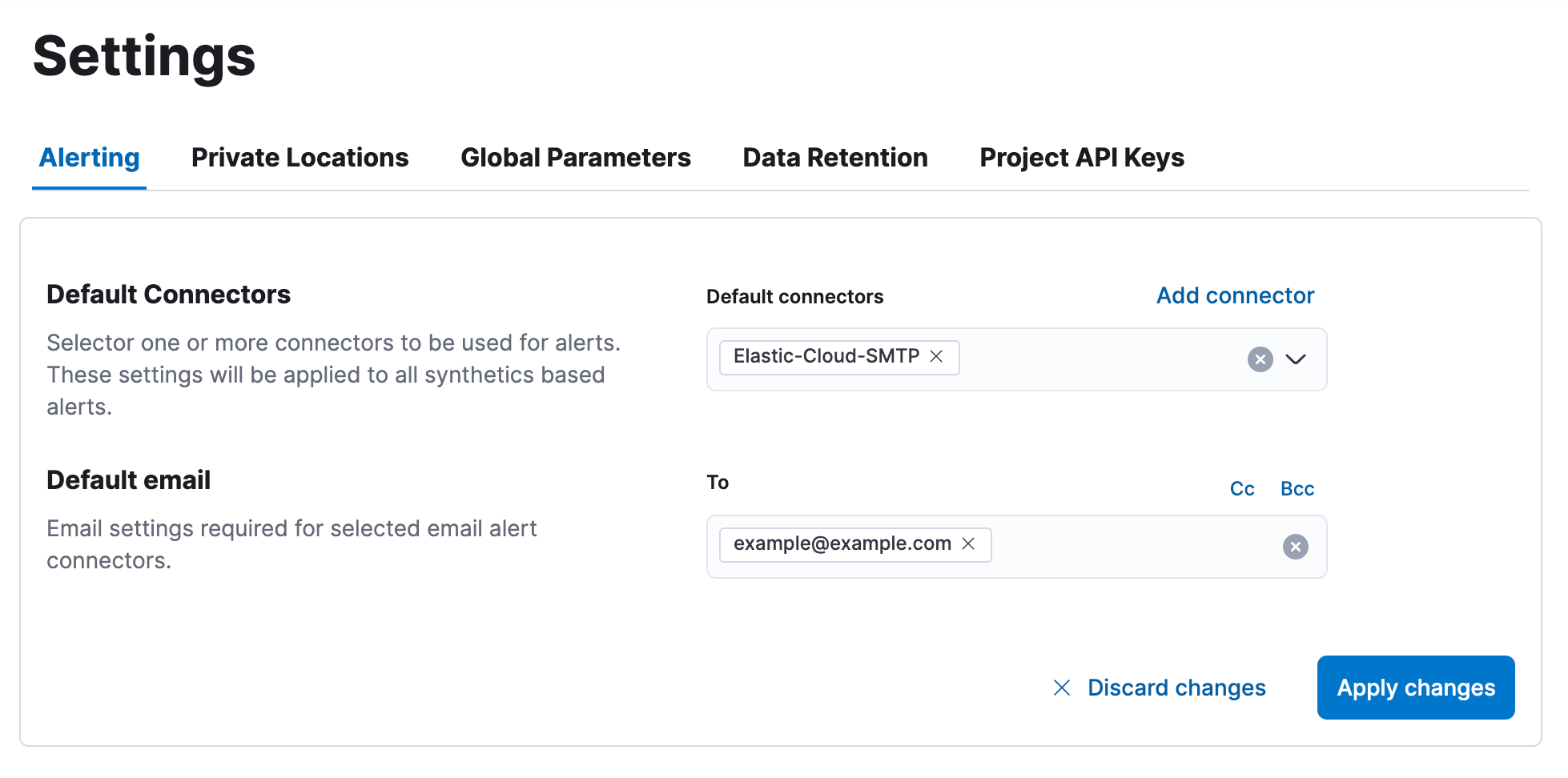
Private Locations
editPrivate Locations allow you to run monitors from your own premises.
In the Private Locations tab, you can add and manage Private Locations. After you Set up Elastic Agent and Connect to your Observability project, this is where you will add the Private Location so you can specify it as the location for a monitor created using the Synthetics UI or a Synthetics project.
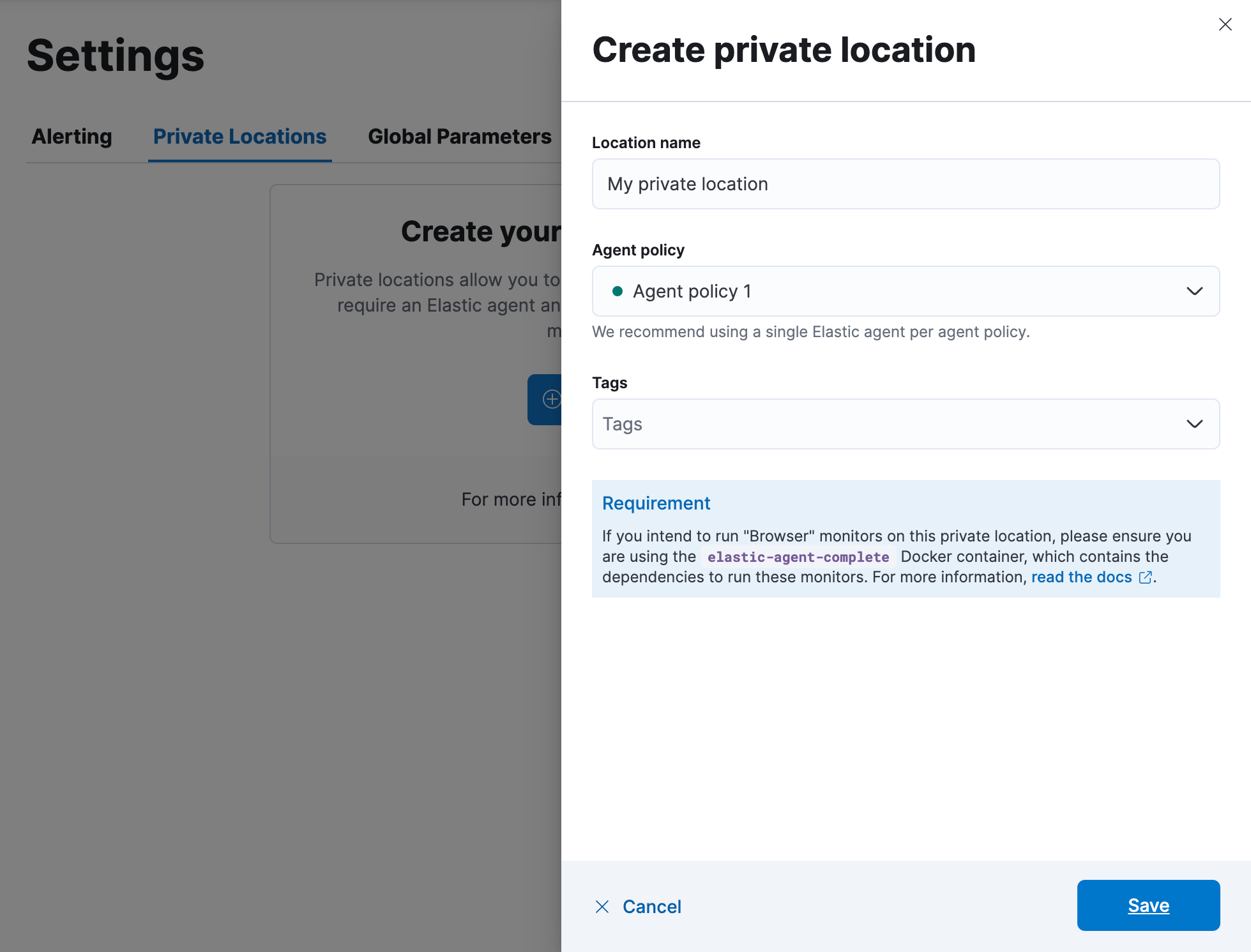
Global parameters
editGlobal parameters can be defined once and used across the configuration of lightweight and browser-based monitors.
In the Global parameters tab, you can define variables and parameters. This is one of several methods you can use to define variables and parameters. To learn more about the other methods and which methods take precedence over others, see Work with params and secrets.

Data retention
editWhen you set up a synthetic monitor, data from the monitor is saved in Elasticsearch data streams, an append-only structure in Elasticsearch. You can customize how long synthetics data is stored by creating your own index lifecycle policy and attaching it to the relevant custom Component Template in Stack Management.
In the Data retention tab, use the links to jump to the relevant policy for each data stream. Learn more about the data included in each data stream in Manage data retention.
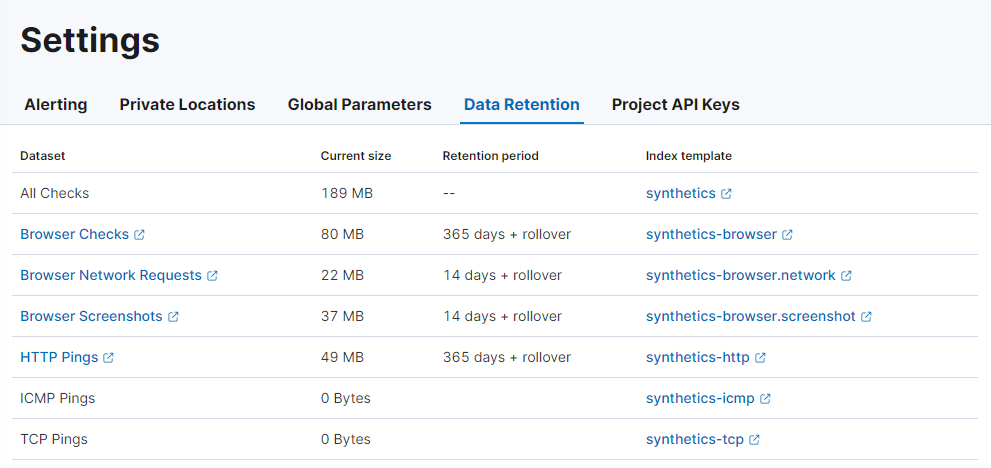
Project API keys
editProject API keys are used to push monitors created and managed in a Synthetics project remotely from a CLI or CD pipeline.
In the Project API keys tab, you can generate API keys to use with your Synthetics project. Learn more about using API keys in Create monitors with a Synthetics project.
To create a Project API key, you must be logged in as a user with Editor access.
